
Extending nanostructures into the third dimension has become a major research avenue in condensed-matter physics, because of geometry- and topology-induced phenomena. Recent fascinating advances of high-tech fabrication techniques have allowed for generating geometrically complex and topologically nontrivial 3D architectures at the micro- and nanoscale, which determine novel, sometimes counterintuitive, electronic, magnetic, optical and transport properties of such objects and unprecedented potentialities for design, functionalization and integration of nanodevices due to their complex geometry and non-trivial topology.
Research touches the following topics in nanophysics (click on the respective topic for key recent publications):
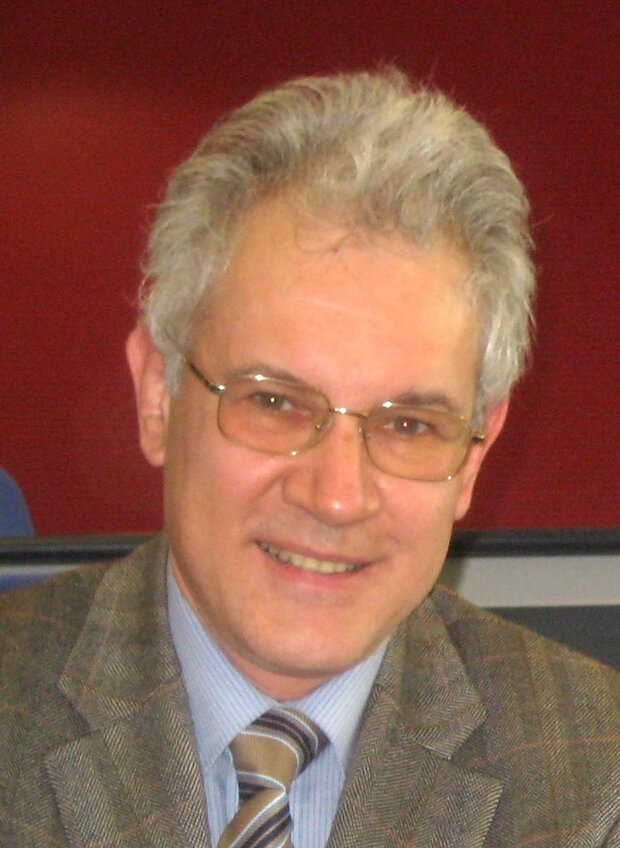
Prof. Dr. Vladimir F. Fomin
Room A3E.16
Phone: +49 351 4659 780
E-mail
V. M. Fomin
Self-rolled micro- and nanoarchitectures: Effects of topology and geometry
De Gruyter, Berlin/Boston, 2021
ISBN: 978-3-11-057410-4, ISBN: 978-3-11-057423-4 (eBook) 148 p.
URL
This book provides an in-depth representation of the advanced theoretical and numerical models developed to analyze key topological and geometrical effects, which underlie engineering of transport, superconducting and optical properties of state-of-the-art self-rolled micro- and nanoarchitectures. Within a holistic approach, the effects of rolling up are analyzed theoretically for superconductor, semiconductor and magnetized micro- and nanoarchitectures, catalytic tubular micromotors and optical waveguides.
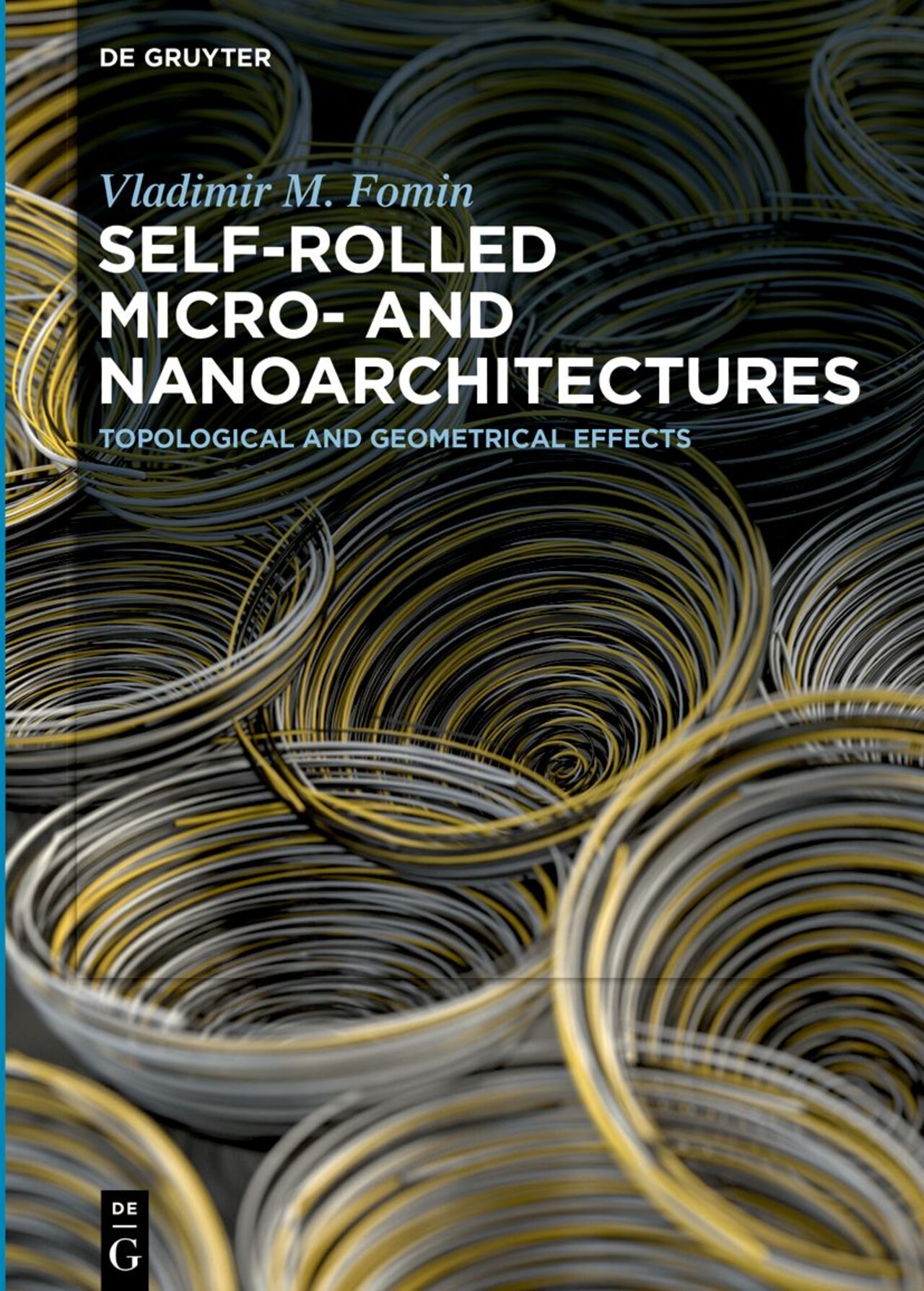
Vladimir M. Fomin
Superconductivity in self-rolled nanoarchitectures
Research Features 138, 98-101 (2021)
URL
V. M. Fomin, R. O. Rezaev, O. V. Dobrovolskiy
Topological transitions in ac/dc-driven superconductor nanotubes
Scientific Reports 12, 10069, 1-10 (2022).
URL
Extending of nanostructures into the third dimension has become a major research avenue in condensed-matter physics, because of geometry- and topology-induced phenomena. In this regard, superconductor 3D nanoarchitectures feature magnetic field inhomogeneity, non-trivial topology of Meissner currents and complex dynamics of topological defects. Here, we investigate theoretically topological transitions in the dynamics of vortices and slips of the phase of the order parameter in open superconductor nanotubes under a modulated transport current. Relying upon the time-dependent Ginzburg–Landau equation, we reveal two distinct voltage regimes when (i) a dominant part of the tube is in either the normal or superconducting state and (ii) a complex interplay between vortices, phase-slip regions and screening currents determines a rich FFT voltage spectrum. Our findings unveil novel dynamical states in superconductor open nanotubes, such as paraxial and azimuthal phase-slip regions, their branching and coexistence with vortices, and allow for control of these states by superimposed dc and ac current stimuli.
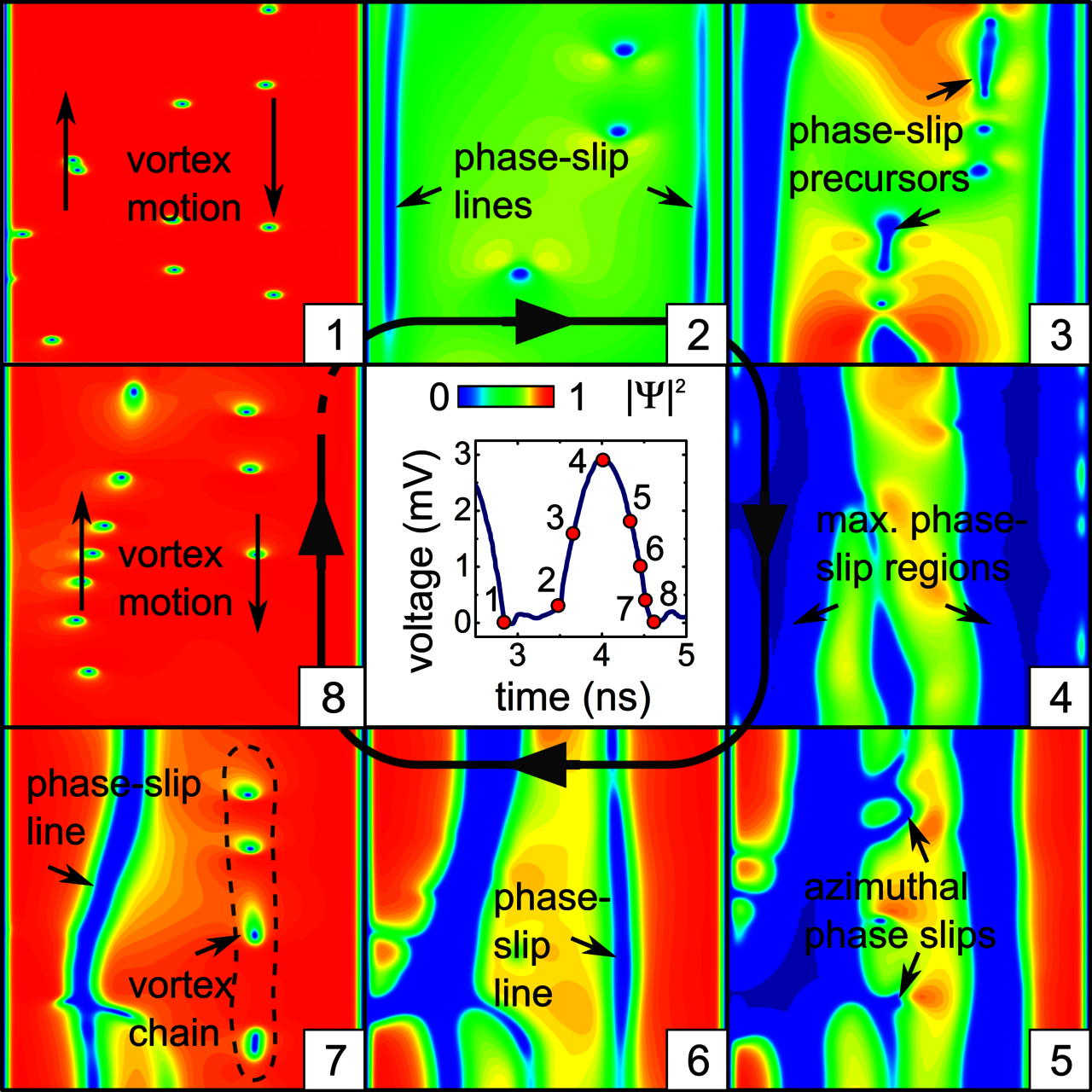
I. Bogush and V. M. Fomin
Topological defects in superconductor open nanotubes after gradual and abrupt switch-on of the transport current and magnetic field
Phys. Rev. B 105, 094511, 1-11 (2022)
URL
We analyze dynamics of the order parameter in superconductor open nanotubes under a strong transport current in an external homogeneous magnetic field using the time-dependent Ginzburg-Landau equation. Near the critical transport current, the dissipation processes are driven by vortex and phase-slip dynamics. A transition between the vortex and phase-slip regimes is found to depend on the external magnetic field only weakly if the magnetic field and/or transport current are switched on gradually. In the case of an abrupt switch-on of the magnetic field or transport current, the system can be triggered to the stable phase-slip regime within a certain window of parameters. Finally, a hysteresis effect in the current-voltage characteristics is predicted in superconductor open nanotubes.
V. M. Fomin, O. V. Dobrovolskiy
A Perspective on superconductivity in curved 3D nanoarchitectures
Appl. Phys. Lett. 120, 090501, 1-12 (2022)
URL
In recent years, superconductivity and vortex matter in curved 3D nanoarchitectures have turned into a vibrant research avenue because of the rich physics of the emerging geometry- and topology-induced phenomena and their prospects for applications in (electro)magnetic field sensing and information technology. While this research domain is still in its infancy, numerous theoretical predictions await their experimental examination. In this Perspective, after a brief introduction to the topical area, we outline experimental techniques capable of fabrication of curved 3D nanostructures and review selected own results on the intertwined dynamics of Meissner currents, Abrikosov vortices, and slips of the phase of the superconducting order parameter therein. We share our vision regarding prospect directions and current challenges in this research domain, arguing that curved 3D nanoarchitectures open up a direction in superconductors' research and possess great potential for magnetic field sensing, bolometry, and fluxonic devices.
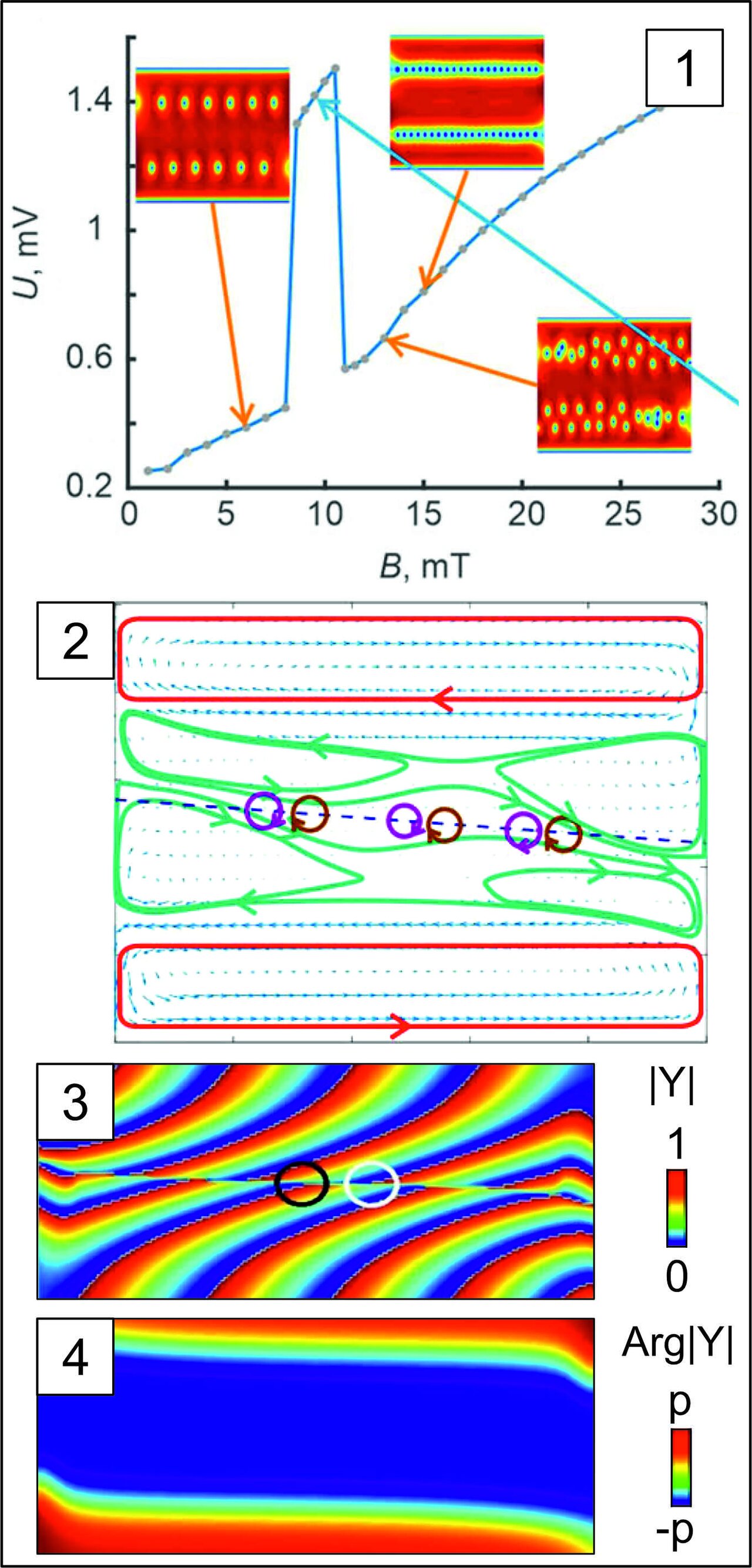
P. Orús, V. M. Fomin, J. M. De Teresa, R. Córdoba
Critical current modulation induced by an electric field in superconducting tungsten-carbon nanowires
Scientific Reports 11, 17698 (2021)
URL
The critical current of a superconducting nanostructure can be suppressed by applying an electric field in its vicinity. This phenomenon is investigated throughout the fabrication and electrical characterization of superconducting tungsten-carbon (W-C) nanostructures grown by Ga+ focused ion beam induced deposition (FIBID). In a 45 nm-wide, 2.7 μm-long W-C nanowire, an increasing side-gate voltage is found to progressively reduce the critical current of the device, down to a full suppression of the superconducting state below its critical temperature. This modulation is accounted for by the squeezing of the superconducting current by the electric field within a theoretical model based on the Ginzburg–Landau theory, in agreement with experimental data. Compared to electron beam lithography or sputtering, the single-step FIBID approach provides with enhanced patterning flexibility and yields nanodevices with figures of merit comparable to those retrieved in other superconducting materials, including Ti, Nb, and Al. Exhibiting a higher critical temperature than most of other superconductors, in which this phenomenon has been observed, as well as a reduced critical value of the gate voltage required to fully suppress superconductivity, W-C deposits are strong candidates for the fabrication of nanodevices based on the electric field-induced superconductivity modulation.
R.O. Rezaev, E.I. Smirnova, O.G. Schmidt, V.M. Fomin
Topological transitions in superconductor nanomembranes in a magnetic field with submicron inhomogeneity under a strong transport current
Communications Physics 3, 144, 1-8 (2020)
URL
The topological defects, vortices in bulk superconductors (SCs) and phase slips in low-dimensional SCs are known to lead to the occurrence of a finite resistance. We report on a topological transition between the both types of topological defects under a strong transport current in an open SC nanotube with a submicron-scale inhomogeneity of the normal-to-the-surface component of the applied magnetic field. When the magnetic field is orthogonal to the axis of the nanotube, which carries the transport current in the azimuthal direction, the phase-slip regime is characterized by the vortex/antivortex lifetime ∼ 10−14 s versus the vortex lifetime ∼ 10−11 s for vortex chains in the half-tubes, and the induced voltage shows a pulse as a function of the magnetic field. The topological transition between the vortex-chain and phase-slip regimes determines the magnetic-field–voltage and current–voltage characteristics of curved SC nanomembranes to pursue high-performance applications in advanced electronics and quantum computing.
R. Córdoba, D. Mailly, R. O. Rezaev, E. I. Smirnova, O. G. Schmidt, V. M. Fomin, U. Zeitler, I. Guillamón, H. Suderow, J. M. De Teresa
Three-Dimensional Superconducting Nanohelices Grown by He+-Focused-Ion-Beam Direct Writing
Nano Lett. 19, 8597-8604 (2019)
URL
Novel schemes based on the design of complex three-dimensional (3D) nanoscale architectures are required for the development of the next generation of advanced electronic components. He+ focused-ion-beam (FIB) microscopy in combination with a precursor gas allows one to fabricate 3D nanostructures with an extreme resolution and a considerably higher aspect ratio than FIB-based methods, such as Ga+ FIB-induced deposition, or other additive manufacturing technologies. In this work, we report the fabrication of 3D tungsten carbide nanohelices with on-demand geometries via controlling key deposition parameters. Our results show the smallest and highest-densely packed nanohelix ever fabricated so far, with dimensions of 100 nm in diameter and aspect ratio up to 65. These nanohelices become superconducting at 7 K and show a large critical magnetic field and critical current density. In addition, given its helical 3D geometry, fingerprints of vortex and phase-slip patterns are experimentally identified and supported by numerical simulations based on the time-dependent Ginzburg–Landau equation. These results can be understood by the helical geometry that induces specific superconducting properties and paves the way for future electronic components, such as sensors, energy storage elements, and nanoantennas, based on 3D compact nanosuperconductors.
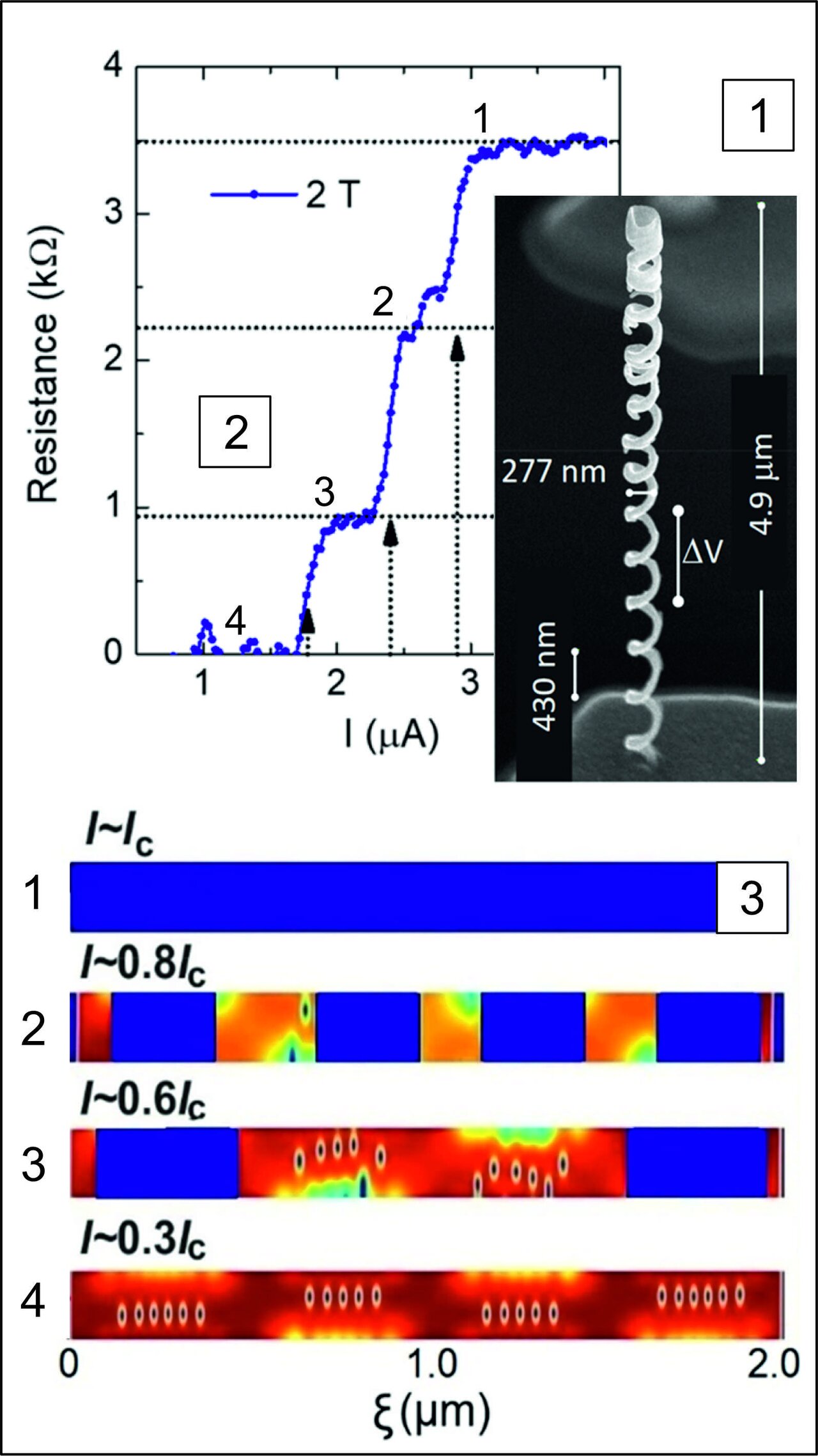
V. M. Fomin (Ed.)
Physics of Quantum Rings, 2nd Edition. Series: NanoSci. Technol.
Springer International Publishing, Cham, 2018
ISBN 978-3-319-95158-4, ISBN 978-3-319-95159-1 (eBook) 586 p.
URL
V.M. Fomin (Ed.)
Physics of Quantum Rings. Series: NanoSci. Technol.
Springer, Berlin - Heidelberg, 2014
ISBN 978-3-642-39196-5, ISBN 978-3-642-39197-2 (eBook), 487 p.
URL
The first edition of this book for the first time in monographic literature provided a broad panorama of the physics of quantum rings. This book in its second edition introduces readers to quantum rings as a special class of modern high-tech material structures at the nanoscale. It deals, in particular, with their formation by means of molecular beam epitaxy and droplet epitaxy of semiconductors, and their topology-driven electronic, optical and magnetic properties. A highly complex theoretical model is developed to adequately represent the specific features of quantum rings. The results presented here are intended to facilitate the development of low-cost high-performance electronic, spintronic, optoelectronic and information processing devices based on quantum rings. This second edition includes both new and significantly revised chapters. It provides extensive information on recent advances in the physics of quantum rings related to the spin-orbit interaction and spin dynamics (spin interference in Rashba rings, tunable exciton topology on type II InAs/GaAsSb quantum nanostructures), the electron-phonon interaction in ring-like structures, quantum interference manifestations in novel materials (graphene nanoribbons, MoS2), and the effects of electrical field and THz radiation on the optical properties of quantum rings. The new edition also shares insights into the properties of various novel architectures, including coupled quantum ring-quantum dot chains and concentric quantum rings, topologic states of light in self-assembled ring-like cavities, and optical and plasmon modes in Möbius-shaped resonators. The book invigorates research interests toward the further development of fundamental insight in and applications of quantum rings.
G. P. Papari and V. M. Fomin
Quantum interference in finite-size mesoscopic rings
Phys. Rev. B 105, 144511, 1-10 (2022)
URL
The Ginzburg-Landau theory is used to model the order parameter of a finite-size mesoscopic ring to investigate the effects of the onset of screening currents on the transport of incoming ones. The magnetic flux breaks the symmetry of currents between input and output stubs by means of an induced spatial ordering upon diamagnetic and paramagnetic supercurrents circulating in the ring. The distribution of those screening currents drives the interference of incoming/outgoing supercurrents resulting into a sinusoidal variation of resistance as a function of the magnetic flux even if the density of quasiparticles is not modified by the external magnetic field.
P. Corfdir, O. Marquardt, R. B. Lewis, C. Sinito, M. Ramsteiner, A. Trampert, U. Jahn, L. Geelhaar, O. Brandt, and V. M. Fomin
Excitonic Aharonov–Bohm Oscillations in Core–Shell Nanowires
Adv. Mater. 31, 1805645, 1-6 (2019)
URL
Phase coherence in nanostructures is at the heart of a wide range of quantum effects such as Josephson oscillations between exciton–polariton condensates in microcavities, conductance quantization in 1D ballistic transport, or the optical (excitonic) Aharonov–Bohm effect in semiconductor quantum rings. These effects only occur in structures of the highest perfection. The 2D semiconductor heterostructures required for the observation of Aharonov–Bohm oscillations have proved to be particularly demanding, since interface roughness or alloy fluctuations cause a loss of the spatial phase coherence of excitons, and ultimately induce exciton localization. Experimental work in this field has so far relied on either self-assembled ring structures with very limited control of shape and dimension or on lithographically defined nanorings that suffer from the detrimental effects of free surfaces. Here, it is demonstrated that nanowires are an ideal platform for studies of the Aharonov–Bohm effect of neutral and charged excitons, as they facilitate the controlled fabrication of nearly ideal quantum rings by combining all-binary radial heterostructures with axial crystal-phase quantum structures. Thanks to the atomically flat interfaces and the absence of alloy disorder, excitonic phase coherence is preserved even in rings with circumferences as large as 200 nm.
J. Wang, S. Valligatla, Y. Yin, L. Schwarz, M. Medina-Sánchez, S. Baunack, C.H. Lee, R. Thomale, S. Li, V. M. Fomin, L. Ma, O.G. Schmidt
Experimental Observation of Berry Phases in Optical Möbius-strip Microcavities
Nature Photonics 17, 120-125 (2023)
URL
The Möbius strip, as a fascinating loop structure with one-sided topology, provides a rich playground for manipulating the non-trivial topological behavior of spinning particles, such as electrons, polaritons, and photons in both real and parameter spaces. For photons resonating in a Möbius-strip cavity, the occurrence of an extra phase, known as Berry phase, with purely topological origin is expected due to its non-trivial evolution in the parameter space. However, despite numerous theoretical investigations, characterizing optical Berry phase in a Möbius-strip cavity has remained elusive. Here we report the experimental observation of Berry phase generated in optical Möbius-strip microcavities. In contrast to theoretical predictions in optical, electronic, and magnetic Möbius-topology systems where only Berry phase π occurs, we demonstrate that variable Berry phase smaller than π can be acquired by generating elliptical polarization of resonating light. Möbius-strip microcavities as integrable and Berry-phase-programmable optical systems are of great interest in topological physics and emerging classical or quantum photonic applications.
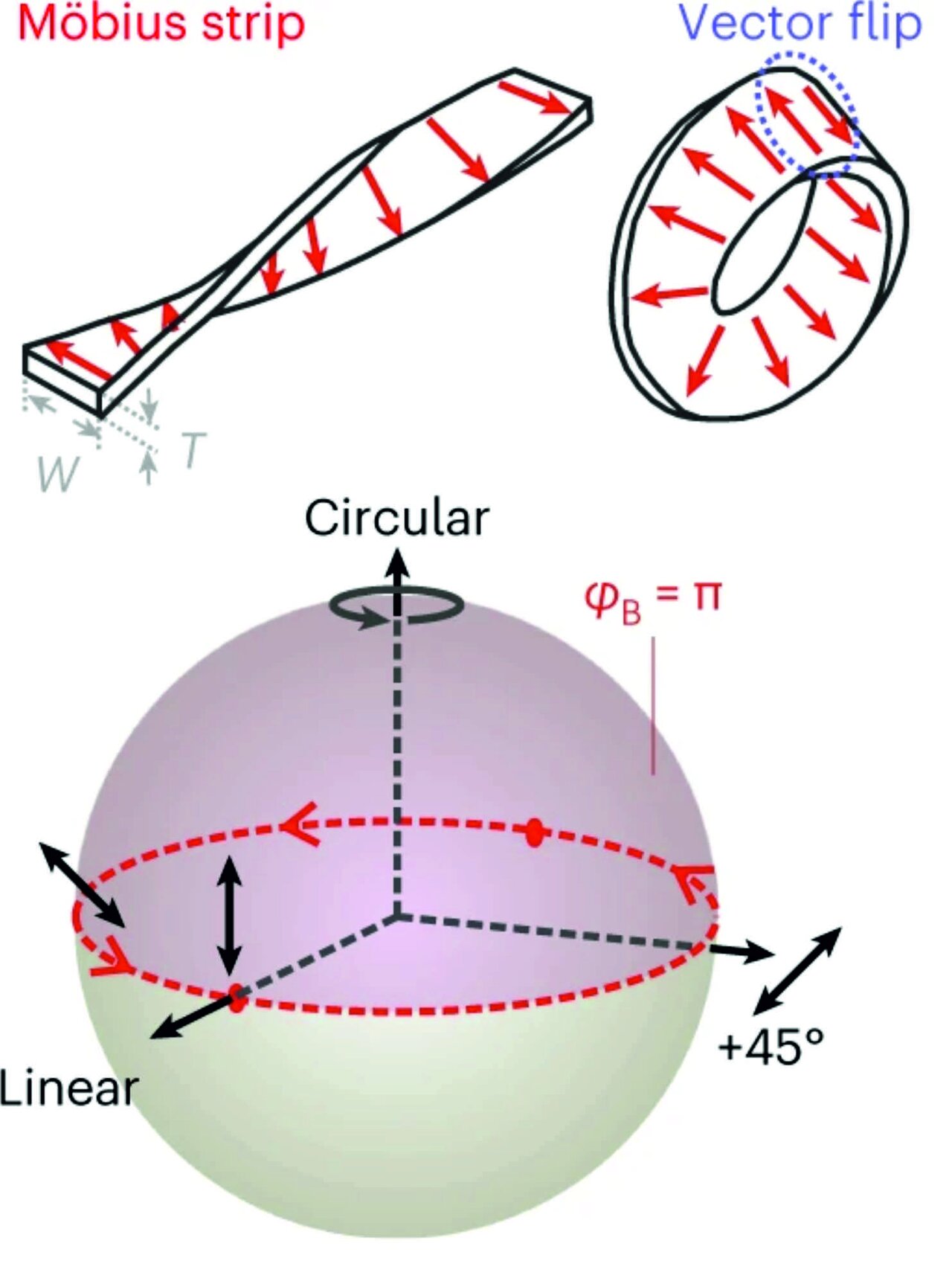
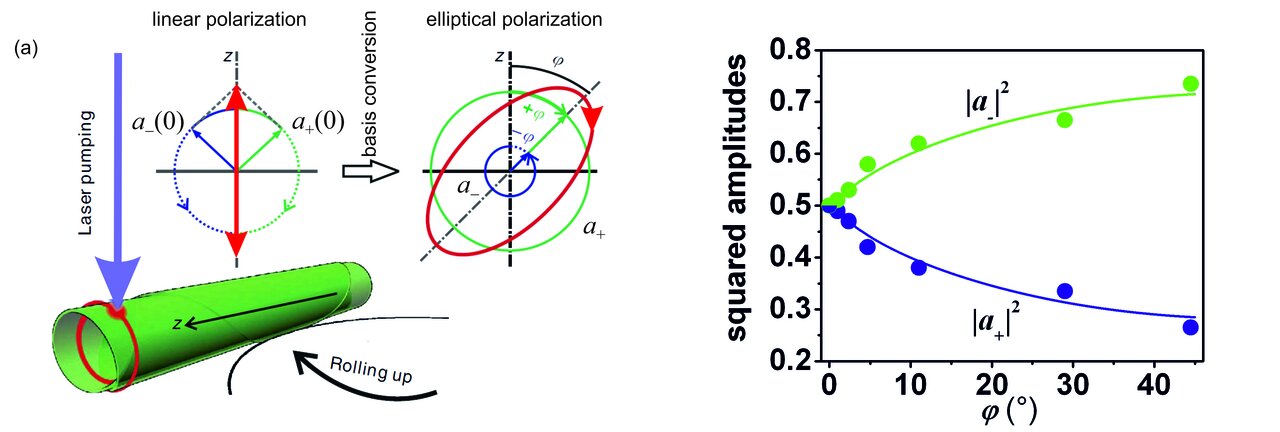
L. B. Ma, S. L. Li, V. M. Fomin, M. Hentschel, J. B. Götte, Y. Yin, M. R. Jorgensen and O. G. Schmidt
Spin–orbit coupling of light in asymmetric microcavities
Nature Commun. 7, 10983, 1-6 (2016)
URL
When spinning particles, such as electrons and photons, undergo spin–orbit coupling, they can acquire an extra phase in addition to the well-known dynamical phase. This extra phase is called the geometric phase (also known as the Berry phase), which plays an important role in a startling variety of physical contexts such as in photonics, condensed matter, high-energy and space physics. The geometric phase was originally discussed for a cyclically evolving physical system with an Abelian evolution, and was later generalized to non-cyclic and non-Abelian cases, which are the most interesting fundamental subjects in this area and indicate promising applications in various fields. Here, we enable optical spin–orbit coupling in asymmetric microcavities and experimentally observe a non-cyclic optical geometric phase acquired in a non-Abelian evolution. Our work is relevant to fundamental studies and implies promising applications by manipulating photons in on-chip quantum devices.
C. Isacova, A. Cocemasov, D. L. Nika, V. M. Fomin
Phonons and thermal transport in Si/SiO2 multishell nano-tubes: Atomistic study
Appl. Sci. 11, 3419 (2021)
URL
Thermal transport in the Si/SiO2 multishell nanotubes is investigated theoretically. The phonon energy spectra are obtained using the atomistic lattice dynamics approach. Thermal conductivity is calculated using the Boltzmann transport equation within the relaxation time approximation. Redistribution of the vibrational spectra in multishell nanotubes leads to a decrease of the phonon group velocity and the thermal conductivity as compared to homogeneous Si nanowires. Phonon scattering on the Si/SiO2 interfaces is another key factor of strong reduction of the thermal conductivity in these structures (down to 0.2 Wm−1K−1 at room temperature). We demonstrate that phonon thermal transport in Si/SiO2 nanotubes can be efficiently suppressed by a proper choice of nanotube geometrical parameters: lateral cross section, thickness and number of shells. We argue that such nanotubes have prospective applications in modern electronics, in cases when low heat conduction is required.
V. M. Fomin
Tailoring Electron and Phonon Energy Dispersion and Thermal transport in Nano- and Microarchitectures
Moldavian Journal of the Physical Sciences 17, 121-131 (2018)
URL
Nanostructuring, as suggested more than two decades ago, creates a timely opportunity to search for new advanced thermoelectric materials. Efficient engineering acoustic phonon energy spectrum has been searched for in rolled-up multishell tubular structures. The strain-driven roll-up procedure is an available instrument for the preparation of multilayer micro- and nanosuperlattices and their arrays. The acoustic phonon dispersion in multishell tubular structures has been analyzed in terms of elastodynamics. It has been shown that the number of shells is an important control parameter of the phonon dispersion together with the structure dimensions and acoustic impedance mismatch between the shells. An increase in the number of shells has been demonstrated to lead to an appreciable decrease in the average and rms phonon group velocity.
G. Li, M. Yarali, A. Cocemasov, S. Baunack, D. L. Nika, V. M. Fomin, S. Singh, T. Gemming, F. Zhu, A. Mavrokefalos, O. G. Schmidt
In-Plane Thermal Conductivity of Radial and Planar Si/SiOx Hybrid Nanomembrane Superlattices
ACS Nano 11, 8215−8222 (2017)
URL
An approach to manage κ of Si thin-film-based nanoarchitectures is elaborated through the formation of radial and planar Si/SiOx hybrid nanomembrane superlattices (HNMSLs). For the radial Si/SiOx HNMSLs with various numbers of windings (1, 2, and 5 windings), we observe a continuous reduction in κ with increasing number of windings. Meanwhile, the planar Si/SiOx HNMSL, which is fabricated by mechanically compressing a five-windings rolled-up microtube, shows the smallest in-plane thermal conductivity among all the reported values for Si-based superlattices. A theoretical model proposed within the framework of the Born–von Karman lattice dynamics to quantitatively interpret the experimental data indicates that the thermal conductivity of Si/SiOx HNMSLs is to a great extent determined by the phonon processes in the SiOx layers.
V. M. Fomin, V. Yu. Timoshenko
Spin-Dependent Phenomena in Semiconductor Micro-and Nanoparticles—From Fundamentals to Applications
Appl. Sci. 10, 4992, 1-45 (2020)
URL
The present overview of spin-dependent phenomena in nonmagnetic semiconductor microparticles (MPs) and nanoparticles (NPs) with interacting nuclear and electron spins is aimed at covering a gap between the basic properties of spin behavior in solid-state systems and a tremendous growth of the experimental results on biomedical applications of those particles. The first part of the review represents modern achievements of spin-dependent phenomena in the bulk semiconductors from the theory of optical spin orientation under indirect optical injection of carriers and spins in the bulk crystalline silicon (c-Si)—via numerous insightful findings in the realm of characterization and control through the spin polarization—to the design and verification of nuclear spin hyperpolarization in semiconductor MPs and NPs for magnetic resonance imaging (MRI) diagnostics. The second part of the review is focused on the electron spin-dependent phenomena in Si-based nanostructures, including the photosensitized generation of singlet oxygen in porous Si and design of Si NPs with unpaired electron spins as prospective contrast agents in MRI. The experimental results are analyzed by considering both the quantum mechanical approach and several phenomenological models for the spin behavior in semiconductor/molecular systems. Advancements and perspectives of the biomedical applications of spin-dependent properties of Si NPs for diagnostics and therapy of cancer are discussed.
S. I. Beril, V. M. Fomin, A. S. Starchuk
Theory of Polarons, Excitons, Bipolarons and Kinetic Effects in Multilayer Structures of Various Geometries and Superlattices [in Russian]
Pridnestrovian University Press, Tiraspol, 2020, 692 p. ISBN: 978-9975-150-70-5
The monograph presents the results of the original research in the field of electron-vibrational processes and electron-hole-phonon systems in multilayer planar, cylindrical, and spherical structures and in planar superlattices. The key description of the polarization vibrational states of the crystal lattice and electron plasma and consideration of electron-vibrational systems in quantum wells of various geometries: planar, cylindrical and spherical, multilayer structures and in planar superlattices.
The theory of the potential created by surface and bulk charges, as well as all types of polarization (surface and bulk, inertial and non-inertial) in multilayer structures of various geometries and superlattices, is developed within a continuum approximation. A Pekar-Fröhelich type Hamiltonian of the electron-phonon interaction is derived for an arbitrary planar structure with quantum wells, for multilayer structures of cylindrical and spherical geometry, and for planar superlattices containing layers with polar optical oscillation. On this basis, the potential energy of electron self-action in planar, cylindrical, and spherical multilayer structures and in planar superlattices is derived, from which the classical limit for the potential energy of image forces follows. The contributions from the self-action effect to the potential relief of the energy band edges for various multilayer structures are analytically calculated. The polaronic states at the contact of polar and nonpolar crystals, in a polar film, at the contact of two polar crystals, in a superlattice, and in a quantum wire in a dielectric medium are studied. The contributions to the renormalization of the energy and effective mass of the electron from the polaron effect and the effect of self-action are calculated. Exciton, biexciton, and impurity states in homeopolar multilayer structures with quantum wells are investigated. The change in the Coulomb electron-hole interaction and the effects of self-action are taken into account. The theory of exciton states in thin polar films and quantum wire in a polar dielectric matrix is developed.
Kinetic phenomena analyzed in the monograph embrace scattering of free charge carriers by polar bulk and surface optical phonons, infrared absorption of light by free electrons assisted by optical phonons in planar multilayer structures with quantum wells, as well as cyclotron-phonon resonance in structures with quantum wells, taking into account the phonon spectra specific for multilayer systems. The theoretical apparatus described in this monograph can be used to study various electronic and optoelectronic processes in multilayer structures with quantum wells and planar superlattices.
C. Trallero-Giner, D. G. Santiago-Pérez, V. M. Fomin
New magneto-polaron resonances in a monolayer of a transition metal dichalcogenide
Scientific Reports 13, 292 (2023)
URL
Transition metal dichalcogenide (TMD) semiconductors are two-dimensional materials with great potential for the future of nano-optics and nano-optoelectronics as well as the rich and exciting development of basic research. The influence of an external magnetic field on a TMD monolayer raises a new question: to unveil the behavior of the magneto-polaron resonances (MPRs) associated with the phonon symmetry inherent in the system. It is shown that the renormalized Landau energy levels are modified by the interplay of the long-range Pekar-Fröhlich (PF) and short-range deformation potential (DP) interactions. This leads to a new series of MPRs involving the optical phonons at the center of the Brillouin zone. The coupling of the two Landau levels with the LO and A1 optical phonon modes provokes resonant splittings of double avoided-crossing levels giving rise to three excitation branches. This effect appears as bigger energy gaps at the anticrossing points in the renormalized Landau levels. To explore the interplay between the MPRs, the electron-phonon interactions (PF and DP) and the couplings between adjacent Landau levels, a full Green's function treatment for the evaluation of the energy and its life-time broadening is developed. A generalization of the two-level approach is performed for the description of the new MPR branches. The obtained results are a guideline for the magneto-optical experiments in TMDs, where three MPR peaks should be observable.
P. Wrede, M. Medina‐Sánchez, V. M. Fomin, O. G. Schmidt
Switching Propulsion Mechanisms of Tubular Catalytic Micromotors
Small 17, 2006449 (2021)
URL
Different propulsion mechanisms have been suggested for describing the motion of a variety of chemical micromotors, which have attracted great attention in the last decades due to their high efficiency and thrust force, enabling several applications in the fields of environmental remediation and biomedicine. Bubble-recoil based motion, in particular, has been modeled by three different phenomena: capillary forces, bubble growth, and bubble expulsion. However, these models have been suggested independently based on a single influencing factor (i.e., viscosity), limiting the understanding of the overall micromotor performance. Therefore, the combined effect of medium viscosity, surface tension, and fuel concentration is analyzed on the micromotor swimming ability, and the dominant propulsion mechanisms that describe its motion more accurately are identified. Using statistically relevant experimental data, a holistic theoretical model is proposed for bubble-propelled tubular catalytic micromotors that includes all three above-mentioned phenomena and provides deeper insights into their propulsion physics toward optimized geometries and experimental conditions.
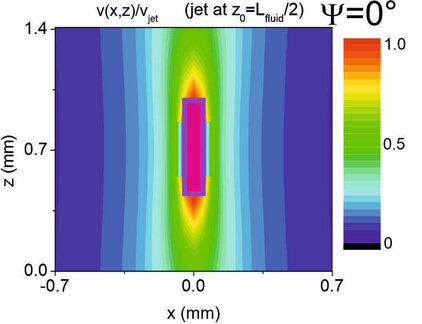
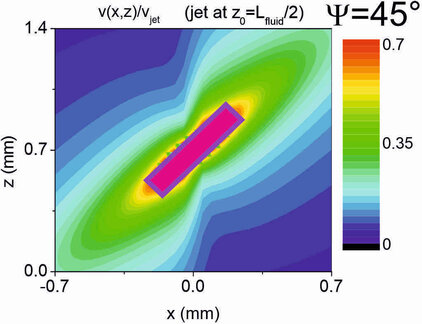
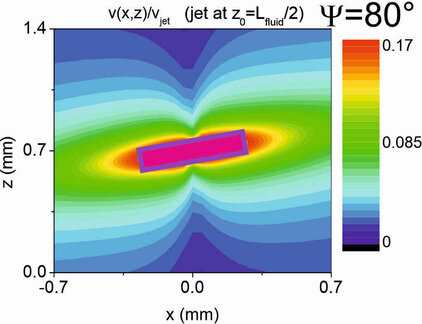
L. Soler, V. Magdanz, V. M. Fomin, S. Sanchez, O. G. Schmidt
Self-Propelled Micromotors for Cleaning Polluted Water
ACS Nano 7, 9611–9620 (2013)
URL
We describe the use of catalytically self-propelled microjets (dubbed micromotors) for degrading organic pollutants in water via the Fenton oxidation process. The tubular micromotors are composed of rolled-up functional nanomembranes consisting of Fe/Pt bilayers. The micromotors contain double functionality within their architecture, i.e., the inner Pt for the self-propulsion and the outer Fe for the in situ generation of ferrous ions boosting the remediation of contaminated water. The degradation of organic pollutants takes place in the presence of hydrogen peroxide, which acts as a reagent for the Fenton reaction and as main fuel to propel the micromotors. Factors influencing the efficiency of the Fenton oxidation process, including thickness of the Fe layer, pH, and concentration of hydrogen peroxide, are investigated. The ability of these catalytically self-propelled micromotors to improve intermixing in liquids results in the removal of organic pollutants ca. 12 times faster than when the Fenton oxidation process is carried out without catalytically active micromotors. The enhanced reaction–diffusion provided by micromotors has been theoretically modeled. The synergy between the internal and external functionalities of the micromotors, without the need of further functionalization, results into an enhanced degradation of nonbiodegradable and dangerous organic pollutants at small-scale environments and holds considerable promise for the remediation of contaminated water.